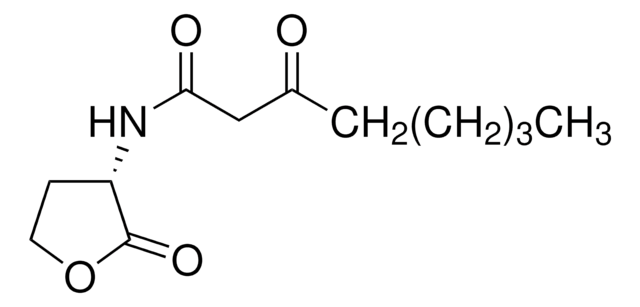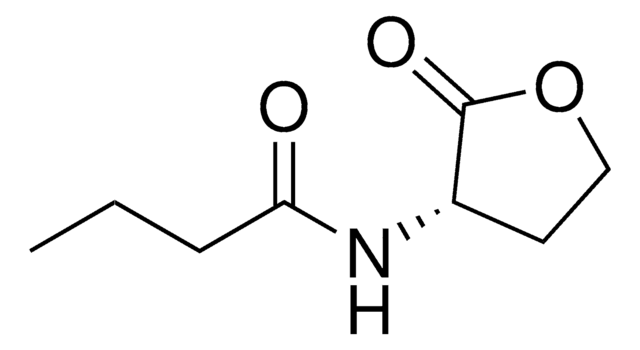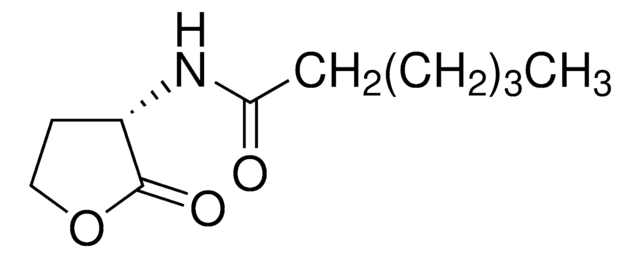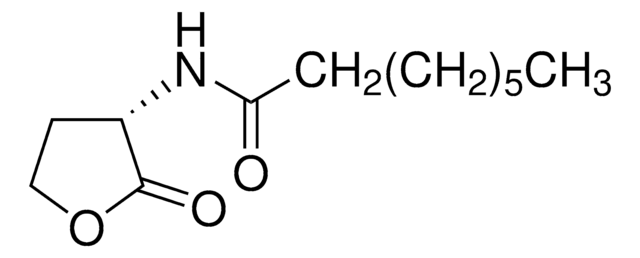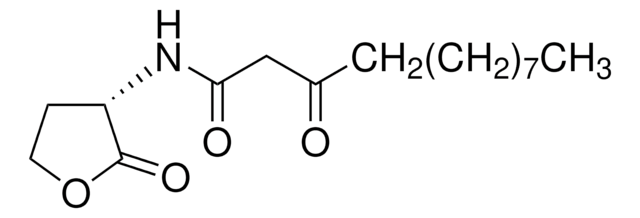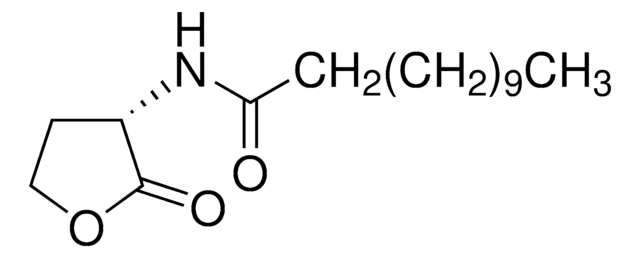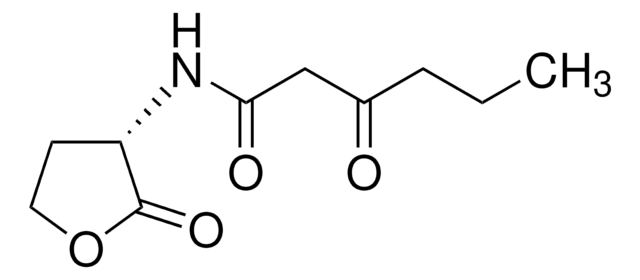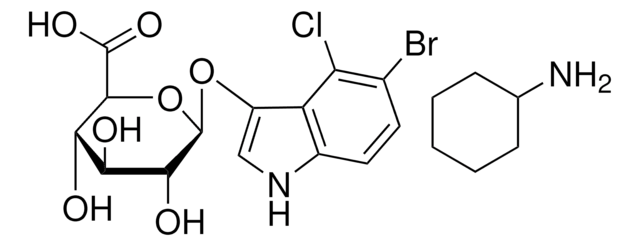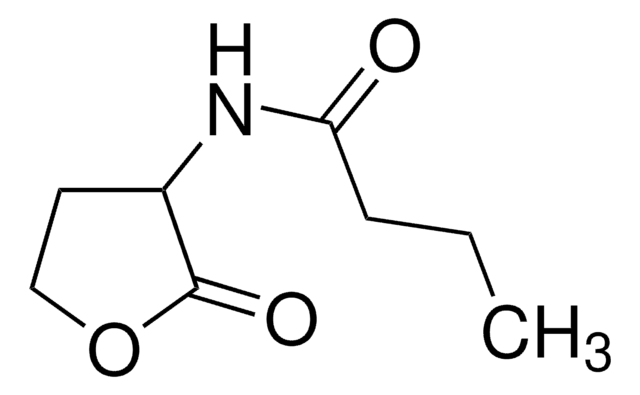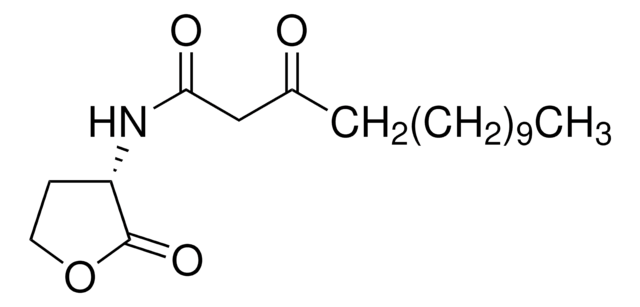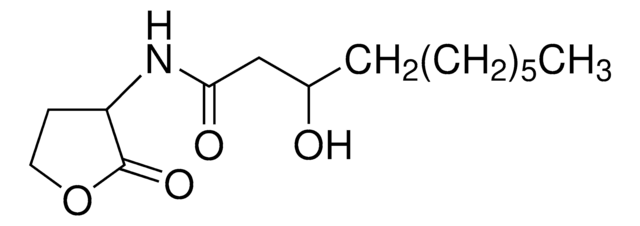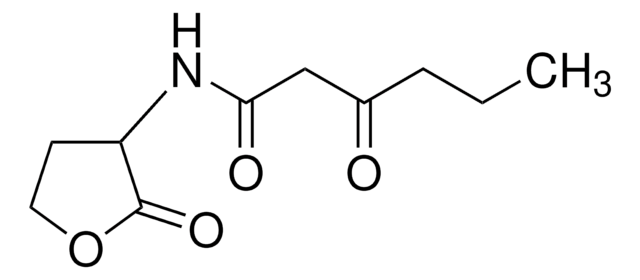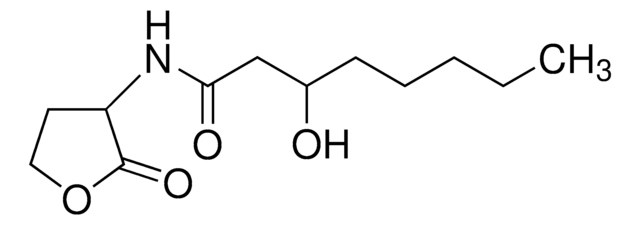07028
N-Decanoyl-L-homoserine lactone
≥96% (HPLC)
Synonym(s):
N-[(3S)-Tetrahydro-2-oxo-3-furanyl]decanamide, C10-HSL
Sign Into View Organizational & Contract Pricing
All Photos(1)
About This Item
Empirical Formula (Hill Notation):
C14H25NO3
CAS Number:
Molecular Weight:
255.35
MDL number:
UNSPSC Code:
12352211
PubChem Substance ID:
NACRES:
NA.85
Recommended Products
Quality Level
Assay
≥96% (HPLC)
form
powder or crystals
optical activity
[α]/D -24±3°, c = 0.2 in methanol
color
white to off-white
suitability
conforms to structure for Proton NMR spectrum
application(s)
cell analysis
storage temp.
−20°C
SMILES string
O=C1OCC[C@@H]1NC(CCCCCCCCC)=O
InChI
1S/C14H25NO3/c1-2-3-4-5-6-7-8-9-13(16)15-12-10-11-18-14(12)17/h12H,2-11H2,1H3,(H,15,16)/t12-/m0/s1
InChI key
TZWZKDULKILUPV-LBPRGKRZSA-N
Biochem/physiol Actions
N-Decanoyl-L-homoserine lactone is a member of N-acyl-homoserine lactone family. N-Acylhomoserine lactones (AHL) regulate gene expression in gram-negative bacteria, such as Echerichia and Salmonella, and are involved in quorum sensing, cell to cell communication among bacteria; for reviews see. Bacterial intercellular communication has become a target for the development of new anti-virulence drugs, and a research focus for the prevention of biofilm formation.
Quorum-sensing signal generation
Storage Class Code
11 - Combustible Solids
WGK
WGK 3
Flash Point(F)
Not applicable
Flash Point(C)
Not applicable
Choose from one of the most recent versions:
Already Own This Product?
Find documentation for the products that you have recently purchased in the Document Library.
Customers Also Viewed
M R Parsek et al.
Proceedings of the National Academy of Sciences of the United States of America, 97(16), 8789-8793 (2000-08-02)
Recent advances in studies of bacterial gene expression have brought the realization that cell-to-cell communication and community behavior are critical for successful interactions with higher organisms. Species-specific cell-to-cell communication is involved in successful pathogenic or symbiotic interactions of a variety
Wen-Zhao Wang et al.
Applied and environmental microbiology, 78(22), 7985-7992 (2012-09-04)
N-acylhomoserine lactones (AHLs) are used as quorum-sensing (QS) signal molecules by many gram-negative bacteria. We have reported that Chryseobacterium sp. strain StRB126, which was isolated from the root surface of potato, has AHL-degrading activity. In this study, we cloned and
Jian Woon Chen et al.
Sensors (Basel, Switzerland), 13(10), 13217-13227 (2013-10-03)
In the bacteria kingdom, quorum sensing (QS) is a cell-to-cell communication that relies on the production of and response to specific signaling molecules. In proteobacteria, N-acylhomoserine lactones (AHLs) are the well-studied signaling molecules. The present study aimed to characterize the
Yanan Cao et al.
Applied and environmental microbiology, 78(6), 1899-1908 (2012-01-17)
N-Acylated homoserine lactone (AHL) lactonases are capable of degrading signal molecules involved in bacterial quorum sensing and therefore represent a new approach to control bacterial infection. Here a gene responsible for the AHL lactonase activity of Bacillus sp. strain AI96
P D Shaw et al.
Proceedings of the National Academy of Sciences of the United States of America, 94(12), 6036-6041 (1997-06-10)
Many Gram-negative bacteria regulate gene expression in response to their population size by sensing the level of acyl-homoserine lactone signal molecules which they produce and liberate to the environment. We have developed an assay for these signals that couples separation
Our team of scientists has experience in all areas of research including Life Science, Material Science, Chemical Synthesis, Chromatography, Analytical and many others.
Contact Technical Service